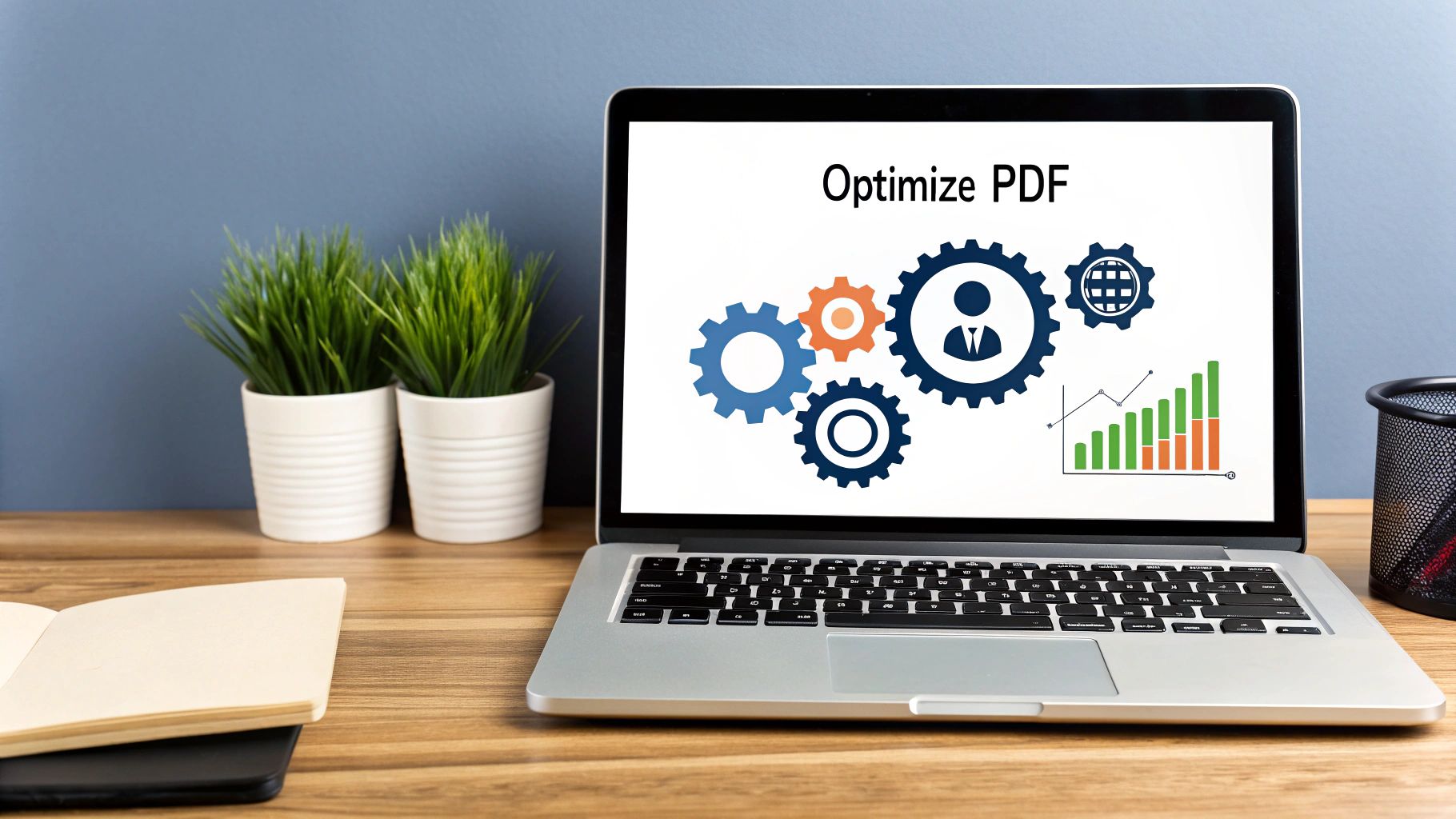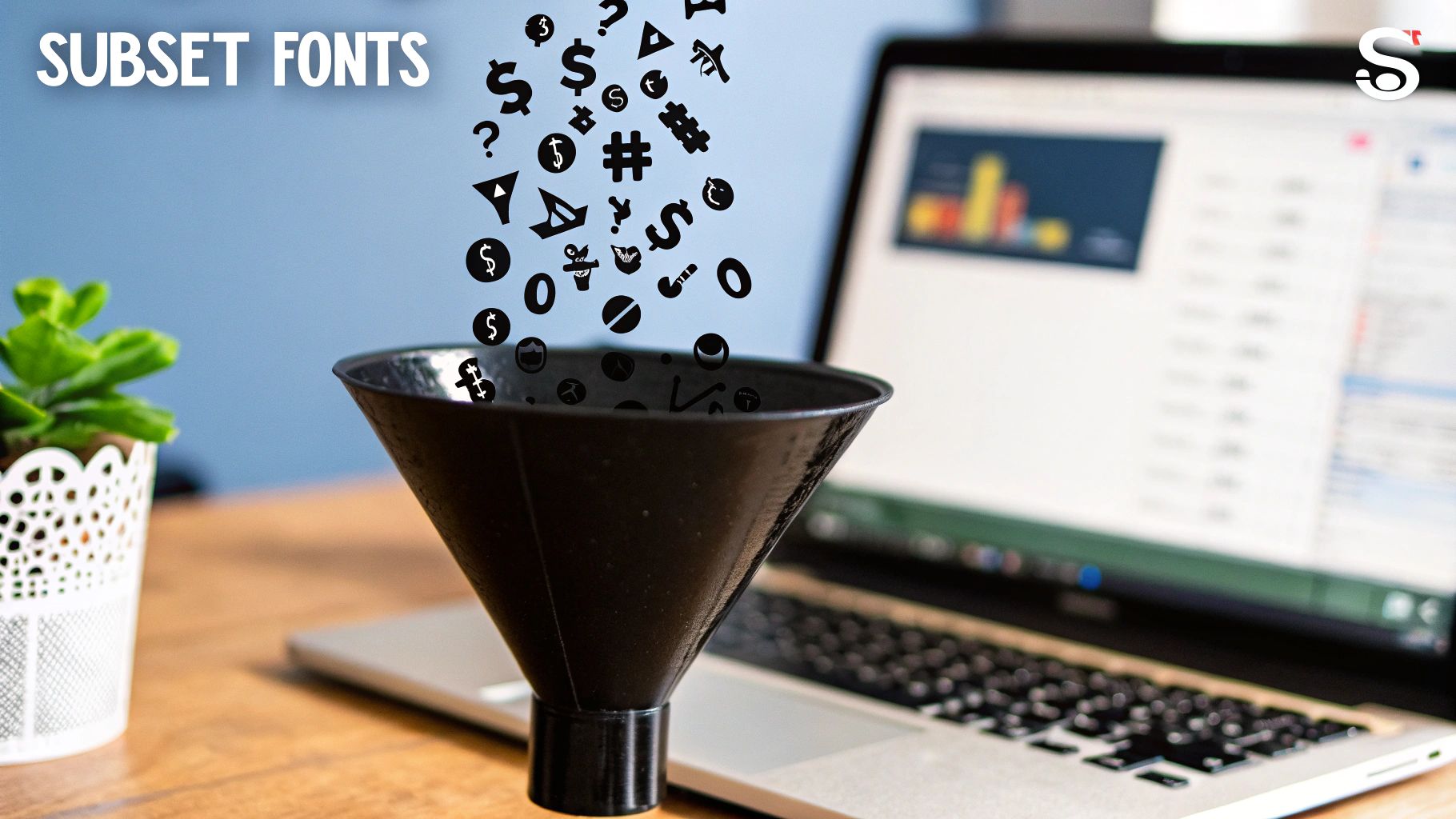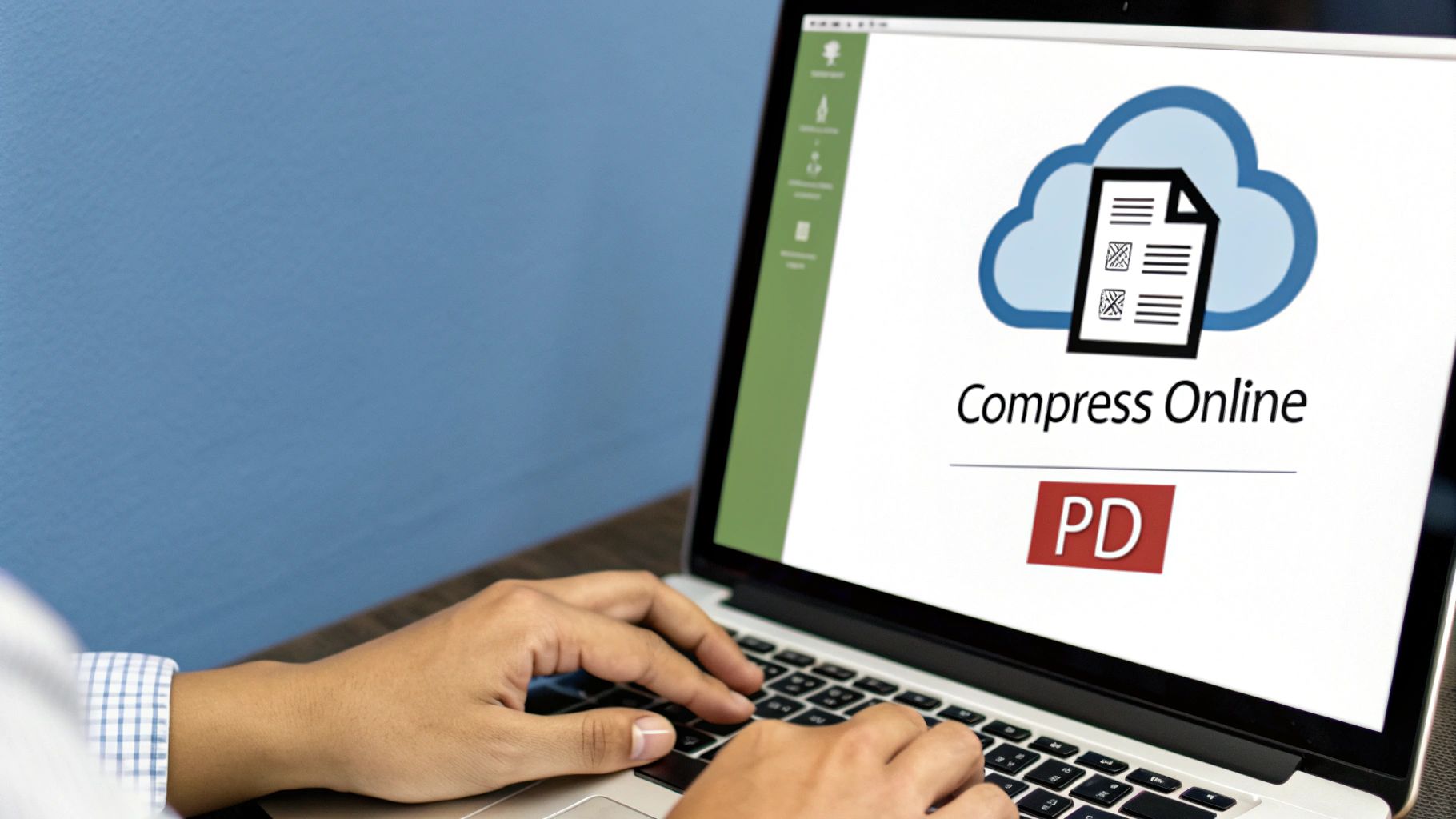Reduce PDF Size Without Losing Quality | Easy Tips & Tools
Shrinking PDFs: Essential for Modern Workflows
Large PDFs hinder productivity. Slow uploads, clogged email, and storage limitations are common frustrations. This listicle provides six practical methods to reduce PDF size without losing quality. Learn how to optimize PDFs for efficient sharing and storage, keeping them crisp and clear. Discover solutions ranging from PDF optimization software and image compression to font subsetting and online compression services. Reclaim storage space and improve workflow efficiency with these essential techniques.
1. PDF Optimization Software
When you need to reduce PDF size without losing quality, dedicated PDF optimization software often provides the best results. These applications employ advanced algorithms to analyze and optimize the various components within a PDF file, intelligently compressing images, removing redundant data, and optimizing the file's internal structure without significantly impacting the visual fidelity of the document. This makes them a powerful tool for anyone working with PDFs, from corporate professionals managing large files to content creators distributing high-quality visuals.

PDF optimization software earns its place at the top of this list due to its comprehensive approach to file size reduction. Unlike simpler methods, these tools offer granular control over the compression process, allowing you to balance file size and quality. Features such as batch processing, multiple compression profiles (ranging from "high quality" to "maximum compression"), and preview capabilities make them particularly efficient and user-friendly. These tools often retain important PDF elements, like forms, hyperlinks, text searchability, and metadata, which can be lost with other compression methods.
Key Features and Benefits:
- All-in-one solution: Handles all aspects of PDF compression within a single application.
- Batch processing: Compress multiple PDF files simultaneously, saving significant time and effort.
- Multiple compression profiles: Choose from pre-defined profiles offering varying levels of compression and quality, or customize your own settings.
- Preview capability: Compare the before-and-after versions of your PDF to ensure the quality is acceptable before saving changes.
- Retention of text searchability and metadata: Preserves critical document information, ensuring the compressed PDF remains fully functional.
Pros:
- User-friendly interfaces: Designed to be accessible even for non-technical users.
- Customizable compression settings: Fine-tune the compression process to meet specific requirements.
- Maintains document fidelity: Generally preserves visual quality better than generic compression methods.
- Preserves interactive elements: Often maintains forms, hyperlinks, and other interactive components.
- Efficient batch processing: Ideal for handling large numbers of PDF files.
Cons:
- Cost: Premium software often requires a paid license.
- Resource intensive: Can consume significant system resources, especially when processing very large or complex PDFs.
- Variable quality: Results can vary based on the specific software and settings used.
- Feature limitations: Some advanced features may be locked behind higher-tier subscriptions.
Examples of Popular PDF Optimization Software:
- Adobe Acrobat Pro: The industry standard, offering a robust PDF Optimizer tool (www.adobe.com).
- Foxit PhantomPDF: A prominent PDF solution known for its File Size Optimizer.
- Nitro Pro: Offers an "Optimize Document" feature for comprehensive PDF compression.
- PDFelement: Includes a "Compress PDF" function for quick and easy file size reduction.
Tips for Using PDF Optimization Software:
- Always preview: Use the preview feature to assess the quality of the compressed PDF before saving.
- Save originals: For critical documents, keep a backup of the original uncompressed file.
- Experiment with profiles: Test different compression profiles to find the best balance between file size and quality.
- Prioritize accessibility: Ensure the software maintains document accessibility features if required.
When to Use PDF Optimization Software:
This approach is ideal when you need to significantly reduce PDF file size while maintaining a high level of visual fidelity and preserving document functionality. It's particularly useful for:
- Sharing large PDF files via email or online platforms.
- Archiving large collections of PDF documents.
- Optimizing PDFs for web publishing.
- Preparing PDFs for print while minimizing file size.
By utilizing dedicated PDF optimization software, you can effectively manage your PDF files, reducing storage space and improving workflow efficiency without compromising document quality.
2. Image Downsampling and Compression
One of the most effective ways to reduce PDF size without losing quality is through image downsampling and compression. This technique focuses specifically on optimizing the images embedded within the PDF, which are often the largest contributors to overall file bloat. Downsampling involves reducing the image resolution—measured in pixels per inch (PPI)—to a level appropriate for the intended use, while compression employs algorithms to reduce the data needed to represent the image without excessive quality degradation. This powerful combination can significantly shrink your PDFs while maintaining readability and visual appeal.

This method offers several key features that make it indispensable for efficient PDF size reduction. You can target specific PPI values for optimal resolution control, and choose between lossy and lossless compression depending on your quality requirements. This flexibility allows you to tailor the process for different image types (color, grayscale, monochrome) and output destinations (web, print). Many tools offering this functionality include options for JPEG, JPEG 2000, ZIP, or CCITT compression and can automatically skip already optimized images, streamlining the workflow.
Why Use Image Downsampling and Compression?
This approach is particularly effective for image-heavy documents like scanned contracts, brochures, or reports. It allows you to achieve drastic file size reductions while preserving text quality and searchability, a crucial factor for maintaining document usability. For instance, reducing a 600 DPI scanned document to 300 DPI for standard viewing can dramatically decrease the file size with minimal impact on perceived quality. Similarly, compressing high-resolution medical imaging PDFs or photographic annual reports makes them more manageable for web distribution and easier to share. Architectural plans with many raster elements can also benefit significantly from this technique.
Pros:
- Dramatically reduces file size for image-heavy documents.
- Can be tailored to the output destination (web, print, etc.).
- Effective even on PDFs created from scanned documents.
- Minimal impact on perceived quality when configured correctly.
- Preserves text quality and searchability.
Cons:
- Aggressive downsampling can make images pixelated.
- May affect document printability at larger sizes.
- Lossy compression introduces some visual artifacts.
- Difficult to reverse once applied.
- Not effective for PDFs without significant image content.
Tips for Optimal Results:
- For print-quality PDFs: Don't downsample below 300 DPI for color/grayscale images.
- For web/screen viewing: 150 DPI is often sufficient.
- Use JPEG compression: Best suited for photographs.
- Use ZIP/lossless compression: Ideal for diagrams, charts, and text-based images.
- Always preview the results: Ensure the final quality meets your specific requirements.
Learn more about Image Downsampling and Compression
This technique, popularized by Adobe Acrobat and leveraged by open-source tools like ImageMagick, represents a cornerstone of effective PDF optimization. Its ability to significantly reduce file size without compromising essential quality makes it a crucial tool for anyone working with PDFs, especially corporate professionals, Mac users seeking advanced compression tools, and content creators who require quality-preserving file size reduction.
3. Font Subsetting and Optimization
One of the most effective ways to reduce PDF size without losing quality, especially for text-heavy documents, is through font subsetting and optimization. This technique focuses on how fonts are embedded within the PDF file. Instead of embedding the entire font file, which can be quite large, font subsetting embeds only the specific characters used in your document. Think of it like packing for a trip – instead of bringing your entire wardrobe, you pack only the clothes you'll actually wear. Furthermore, font optimization takes this a step further by converting fonts to more efficient formats, further shrinking the file size. This combination provides significant size reduction without compromising the visual integrity of your text.

This method shines in documents utilizing numerous fonts, especially decorative or non-standard ones. Imagine a corporate report with a branded typeface, multiple graphs, and various language scripts. Font subsetting and optimization ensures that only the necessary glyphs for each font are embedded, drastically reducing the overall file size. Features like merging similar font subsets and removing unused font information contribute to further optimization. Importantly, these techniques maintain text searchability and select/copy functionality, crucial for usability.
Benefits of Font Subsetting and Optimization:
- Significant Size Reduction: Particularly effective for documents with many or unusual fonts, achieving reductions of 20-50% in file size.
- Preserves Quality: No visible loss in text quality; maintains the exact text appearance and layout.
- Works Across Scripts: Functions effectively for documents utilizing non-Latin scripts like Chinese, Japanese, or Korean.
- Maintains Functionality: Keeps text searchable and selectable, ensuring document usability.
Pros and Cons:
| Pros | Cons |
|---|---|
| Particularly effective for documents with many fonts | May affect text editability in certain PDF editors |
| No visible quality loss for text | Excessive subsetting can cause issues when adding text later |
| Preserves exact text appearance and layout | May not preserve full language support for modified documents |
| Works well for documents in non-Latin scripts | Limited effectiveness for documents with few fonts |
| Can reduce file size by 20-50% for font-heavy documents | Potential compatibility issues with very old PDF readers |
When and Why to Use This Approach:
This method is ideal for final versions of documents, particularly those intended for distribution or archiving, where further editing is unlikely. Examples include academic publications with mathematical symbols and multiple languages, corporate reports using branded fonts, multilingual documents, or design portfolios showcasing various typography styles. Content creators, Mac users seeking advanced compression tools, and corporate professionals managing large files will find this particularly useful.
Tips for Effective Font Subsetting and Optimization:
- 100% Subsetting for Final Documents: Use 100% subsetting for documents that won't be edited further.
- Threshold Subsetting: For documents requiring potential edits, set a threshold (e.g., embed if less than 75% of the font is used).
- Convert to Outlines Cautiously: Convert decorative fonts to outlines only when absolutely necessary, as this makes text uneditable.
- Maintain Embedded Subsets for Searchability: Ensure embedded subsets are maintained if text search functionality is required.
- Test Compatibility: Test optimized documents on target platforms and PDF readers to ensure compatibility.
Font subsetting and optimization technology has been popularized by Adobe Systems and endorsed by the PDF Association’s best practices. Type foundries also promote efficient font usage within PDFs. This method earns its place on this list because it offers a potent combination of significant file size reduction and preservation of quality, making it an essential tool for anyone working with PDFs.
4. Online PDF Compression Services
Online PDF compression services offer a convenient way to reduce PDF file sizes without losing quality, directly within your web browser. These services utilize powerful compression algorithms on their servers, eliminating the need for specialized software installations. You simply upload your PDF, choose a compression level (if available), and the service processes the file, returning a smaller version ready for download. This approach is particularly useful for reducing PDF size without losing quality, a crucial aspect for maintaining professional document presentation.

One of the key benefits of using online PDF compression services is their accessibility. They work on any device with an internet connection, from desktops and laptops to tablets and smartphones, making them a truly cross-platform solution. This is especially appealing to Mac users who might find limited compatible desktop software options or corporate professionals working across different operating systems. Content creators also benefit significantly as optimized PDFs ensure faster website loading times and efficient sharing of high-quality visuals. Learn more about Online PDF Compression Services for a professional's perspective on file compression. Many services offer various compression levels, allowing you to balance file size reduction with visual fidelity. Some premium services even offer batch processing, allowing you to compress multiple PDFs simultaneously. Integration with cloud storage services further streamlines the workflow. Several online tools can help you reduce PDF file sizes without sacrificing quality. One such tool is PDF.ai's Compress PDF, which offers robust compression capabilities.
Features:
- No software installation required
- Cross-platform compatibility
- Various compression levels (often available)
- Simultaneous processing of multiple PDFs (premium tiers)
- Integration with cloud storage services (some services)
- Immediate download of compressed files
Pros:
- Accessible from any internet-connected device
- Often free for basic usage
- No local computational resources required
- Regularly updated compression algorithms
- Quick processing for most documents
Cons:
- Privacy concerns for sensitive documents
- File size limitations (especially in free versions)
- Limited customization options compared to desktop software
- Requires a stable internet connection
- May include watermarks on free versions
- Potential queue times during high-traffic periods
Examples of Successful Implementation:
- Smallpdf: Their compression service boasts processing over 1 billion documents.
- iLovePDF: Frequently used for quick compression before sending email attachments.
- PDF2Go: Utilized by students to compress large research papers.
- CleverPDF: Employed by small businesses for optimizing document sizes.
Tips for Using Online PDF Compression Services:
- Use services with SSL encryption for sensitive documents.
- Check privacy policies regarding data retention.
- Download and verify the compressed file's quality before deleting originals.
- Consider paid subscriptions for batch processing and advanced features.
- Use browser bookmarks to save your preferred services for quick access.
- Look for services that delete files after processing for enhanced privacy.
Online PDF compression services provide an excellent solution for anyone needing to reduce pdf size without losing quality quickly and easily. Their accessibility, combined with powerful server-side compression algorithms, makes them a valuable tool for both casual and professional users. By understanding the pros and cons and following the tips provided, you can effectively leverage these services to manage your PDF files efficiently while preserving their quality.
5. Content Flattening and Transparency Reduction
When seeking to reduce PDF size without losing quality, content flattening and transparency reduction offer a powerful solution, particularly for files originating from design software. This technique simplifies the PDF's structure, making it smaller and more manageable while preserving visual fidelity. It deserves its place on this list because it tackles a common source of large PDF files: complex layers and transparency effects.
How It Works:
Content flattening effectively merges multiple layers, transparent objects, and interactive elements within a PDF into a single, flattened layer. Imagine a layered cake – flattening it would result in a single, dense slab. Similarly, in a PDF, this process unifies overlapping elements, simplifies complex graphic structures, and converts vector transparency to raster when necessary. Transparency reduction specifically targets semi-transparent elements, converting them to opaque objects for simpler rendering and smaller file size.
Features and Benefits:
- Merges multiple layers: Simplifies the PDF structure for improved efficiency.
- Converts vector transparency to raster: Reduces complexity for easier handling by PDF readers.
- Unifies overlapping elements: Combines overlapping objects into a single layer.
- Simplifies complex graphic structures: Reduces the computational burden for rendering the PDF.
- Reduces computational requirements for rendering: Improves display speed, especially on less powerful devices.
When and Why to Use This Approach:
This method excels when dealing with PDFs rich in design elements, such as those exported from Adobe Illustrator or QuarkXPress. It’s especially helpful for:
- Architectural plans: Flattening overlay layers makes large files easier to share and print.
- Marketing materials: Optimizes transparency effects for consistent printing and smaller file sizes.
- Design files with effects: Prepares files with drop shadows and glows for widespread distribution.
- Technical diagrams: Simplifies complex exploded views for easier interpretation.
Pros:
- Highly effective for design software exports with numerous layers.
- Resolves printing issues associated with complex transparent elements.
- Enhances compatibility with older PDF readers.
- Reduces file size for documents with intricate effects.
- Improves rendering speed, especially on less capable devices.
Cons:
- Reduces the editability of the PDF, as layers are merged.
- May slightly reduce the quality of specific visual elements, especially if resolution settings are not optimized during flattening.
- Can potentially increase file size if applied inappropriately, such as flattening simple documents without complex elements.
- Eliminates layers used for toggling content visibility, impacting interactive functionality.
- Removes some interactive capabilities embedded in the PDF.
Examples of Successful Implementation:
- An architectural firm distributes flattened PDFs of building plans to contractors, ensuring consistent printing and reducing file size for easier sharing.
- A marketing agency optimizes marketing brochures with transparency effects for print production, avoiding color discrepancies and ensuring accurate reproduction.
Actionable Tips for Reducing PDF Size Without Losing Quality Using Flattening:
- Save an unflattened version: Preserve the original layered file for future editing.
- Use appropriate presets: Utilize flattening presets tailored to the intended output (print, web, etc.).
- Higher resolution for small text: Maintain readability when flattening documents containing fine print.
- Preview flattened content: Check for unexpected artifacts or quality degradation before finalizing.
- Correct color output: Ensure the proper color space (CMYK for print, RGB for web) is selected before flattening.
Popularized By:
The need to reduce PDF size without losing quality through flattening and transparency reduction has been driven by applications like Adobe Illustrator, QuarkXPress, PDF/X standards, and the commercial printing industry. These influences highlight the importance of this technique for professional workflows.
6. Object Removal and Structure Optimization
One of the most effective ways to reduce PDF size without losing quality is through object removal and structure optimization. This technique delves into the inner workings of your PDF, identifying and removing unnecessary elements that bloat the file size without contributing to the visible content. Think of it as decluttering your digital document, leaving only the essential components. This method is particularly valuable when you need to reduce PDF size without losing quality, a common requirement for professionals dealing with large or complex documents.
This process involves several key features:
- Removing Unused Objects: Eliminating embedded fonts that aren't used, discarded images, and other leftover data from the document's creation process.
- Cleaning Document Structure: Streamlining the PDF's internal structure by removing redundant information and optimizing object references. This is akin to reorganizing a cluttered closet – everything is still there, just arranged more efficiently.
- Optimizing Internal Cross-References and Pointers: Improving how different parts of the PDF refer to each other, reducing redundancy and improving file access speed.
- Removing Hidden Layers, Comments, and Unused Form Fields: Stripping away non-visible elements that contribute to file size but don't impact what the user sees.
- Eliminating Duplicate Elements and Redundant Structures: Removing copied content or structural elements that may have accumulated during editing.
Why use this approach?
This method is especially effective for PDFs created from inefficient sources, such as those converted from other file formats or those that have undergone multiple rounds of edits. These processes can often leave behind digital "baggage" that inflates the file size unnecessarily.
Pros:
- No Visual Change to Document Content: The optimization occurs behind the scenes, leaving the visual appearance of your PDF untouched.
- Effective for PDFs from Inefficient Sources: Significant size reduction can be achieved, particularly with PDFs generated from complex applications.
- Can Remove Sensitive Metadata Automatically: This can be crucial for ensuring privacy and confidentiality before sharing documents.
- Improves Document Structure for Better Performance: Optimized PDFs often open and load faster.
Cons:
- May Remove Information Needed for Accessibility Features: Certain metadata and structural elements might be essential for accessibility, so caution is advised.
- Can Eliminate Important Metadata for Document Management: If metadata related to document history or versioning is important, ensure backups are made before optimization.
- Potential Loss of Interactive Features: Certain interactive elements, like form fields or embedded multimedia, could be inadvertently removed if not handled carefully.
- Results Vary Depending on Document Origin: The degree of size reduction achieved will depend on the complexity and initial structure of the PDF.
Examples of Successful Implementation:
- Legal documents stripped of revision comments before client delivery.
- Educational materials optimized after multiple editorial rounds.
- Company presentations cleaned of speaker notes before public sharing.
- Government forms with unnecessary hidden fields removed.
Actionable Tips:
- Run a PDF analysis to identify structural issues before optimization.
- Save original files when removing potentially important metadata.
- Keep accessibility information when compressing documents for public use.
- Use the 'audit document space usage' feature when available in your PDF software.
- Pay attention to whether bookmarks and links should be preserved.
Learn more about Object Removal and Structure Optimization
This method is popularized by PDF specification engineers at Adobe, open-source tools like the QPDF library, and various document management systems. It’s a powerful technique for anyone seeking to reduce PDF size without losing quality, from corporate professionals managing large files to content creators distributing their work. By understanding the underlying structure of your PDF and leveraging the right tools, you can significantly reduce file size while preserving the integrity of your document.
6 Techniques for Quality PDF Size Reduction Comparison
| Technique | 🔄 Implementation Complexity | 💡 Resource Requirements | 📊 Expected Outcomes | ⚡ Ideal Use Cases | ⭐ Key Advantages |
|---|---|---|---|---|---|
| PDF Optimization Software | Moderate – user-friendly with presets | Medium to High – depends on file size and batch processing | High – balanced size reduction while preserving quality | General PDF compression, batch processing, professional use | All-in-one solution, batch processing, preserves interactive elements |
| Image Downsampling and Compression | Moderate – requires image-specific settings | Low to Medium – focused on image processing | Very High – significant reduction in image-heavy PDFs | Image-rich PDFs, scanned documents, web or print optimization | Dramatic size reduction for images, tailored compression |
| Font Subsetting and Optimization | Moderate – technical but automated in tools | Low – font data handling only | Medium to High – reduces font-heavy document size | Text-heavy documents with multiple fonts or scripts | Substantial size reduction without visible quality loss |
| Online PDF Compression Services | Low – no installation, web-based | Very Low – uses remote servers | Medium – good compression for standard files | Quick compression, casual users, cross-platform needs | No installation, quick access, updated algorithms |
| Content Flattening and Transparency Reduction | High – requires understanding of layers and transparency | Medium – depends on content complexity | Medium – reduces complexity, improves compatibility | Design-heavy PDFs, print preparation, layered files | Solves transparency issues, improves rendering speed |
| Object Removal and Structure Optimization | Moderate to High – needs careful structural analysis | Low to Medium – structural cleanup | Medium – reduces size without visual change | PDFs from inefficient sources or multiple edits | Removes unnecessary elements, improves performance without content change |
Taking Control of Your PDF Size
Managing PDF size is crucial for efficient workflows and seamless collaboration. We've explored six key techniques to reduce PDF size without losing quality: leveraging PDF optimization software, downsampling and compressing images, optimizing fonts, using online PDF compression services, flattening content and reducing transparency, and strategically removing objects and optimizing document structure. By implementing these strategies, you can significantly reduce file sizes for image-heavy documents, text-rich reports, or complex designs, making them easier to share, upload faster, and store more efficiently. Mastering these approaches empowers you to maintain the visual integrity of your documents while optimizing them for a smoother, more productive digital experience, whether you're a corporate professional, a Mac user, or a content creator. This translates to less time wasted on uploads and downloads, more storage space availability, and a more professional presentation of your work.
Taking control of your PDF size doesn't have to be a complex undertaking. For Mac users seeking an advanced, quality-focused approach, Compresto offers a streamlined solution to reduce PDF size without losing quality. Want to experience hassle-free PDF compression? Try Compresto today at Compresto and optimize your PDFs with ease.